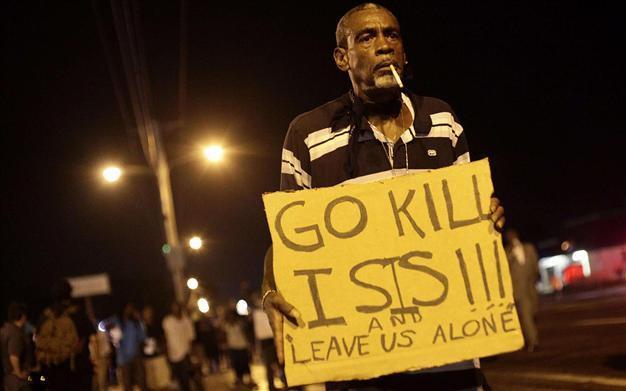US attorney general visits Missouri town for meetings on fatal shooting
FERGUSON - Reuters

A demonstrator protests the shooting death of Michael Brown Aug. 20. AFP Photo
U.S. Attorney General Eric Holder met with community members in Ferguson, Missouri, on Aug. 21 and vowed a thorough civil rights probe into the fatal police shooting of an unarmed black teenager that has set off 12 nights of racially charged protests.
Holder, the first African-American to head the Justice Department, spoke in person with students and then community leaders at a community college during a visit to Ferguson for a briefing on a Justice Department investigation into the Aug. 9 killing of 18-year-old Michael Brown.
He later met for about 20 minutes with Brown's parents at the St. Louis U.S. Attorney's Office. No details of the private session were divulged, but a person familiar with the encounter quoted Holder as promising "a fair and independent inquiry" when family members asked him about the investigative process.
Before meeting with Holder, Brown's mother viewed her son's body at a local morgue for the first time since he was shot, the same person told reporters.
Also on Aug. 20, a grand jury began hearing evidence in the case, though protesters stepped up their demands that the local criminal probe be turned over to a special prosecutor.
Before a briefing at local FBI headquarters, Holder said the thrust of his department's inquiry differed from the investigation conducted by local authorities.
"We are looking for violations of federal, criminal civil rights statutes," he said. The Justice Department is seeking specifically to determine whether federal prosecutors can bring criminal charges against Darren Wilson, the police officer who shot Brown, for violating Brown's civil rights by use of excessive force.
His visit came hours after dozens of protesters were arrested in the latest street disturbances. Many of the protests have been peaceful, but others, especially smaller ones late at night, have been punctuated by looting, vandalism and clashes between demonstrators and police.
Eyes of the worldThe turmoil has cast the St. Louis suburb of 21,000 people into the international spotlight as a symbol of often troubled U.S. race relations.
Ferguson is predominantly black, but its police force, political leadership and public education administration are dominated by whites. Activists and demonstrators have complained that Brown's death was the culmination of years of unfair police targeting of blacks.
An hour before sundown on Wednesday, a few dozen protesters began marching peacefully along a main thoroughfare that has been the scene of nightly demonstrations and sporadic violence.
The group chanted: "Hands up, don't shoot," which has become demonstrators' rallying cry, as they moved along a street fronted by businesses with boarded-up windows and the ruins of a gasoline station burned out in a previous night of unrest.
A thunderstorm and heavy rains struck just after dark, scattering demonstrators, including an angry crowd that had surrounded a couple carrying a pro-police sign. Officers intervened to rescue the couple and escorted them to safety.
Some protesters returned to the streets as showers abated. Among students meeting with Holder at St. Louis Community College was Molyric Welch, 27, who said her brother died three years ago after Ferguson police used a stun gun on him.
"A lot has happened here," she said. "He (Holder) promised things were going to change."
But Melvin Brown, 61, a pastor visiting Ferguson from Rockford, Illinois, to support the protests, was skeptical. "I don't have any faith in it," he said. "The whole system is corrupt."
Grand jury St. Louis County Prosecuting Attorney Bob McCulloch said his office could continue presenting evidence to the grand jury - which meets once a week - through mid-October as he confronts conflicting pressures for speed and thoroughness.
"On one side, people are saying: 'You're rushing to justice,' and on the other side, they're saying: 'You're dragging this thing out,'" he told a news conference. "We're going to present this as expeditiously as possible, but we are not going to present it in a half-hearted manner."
Outside McCulloch's office, scores of protesters led by clergy members called for his removal from the case. They also demanded the appointment of a special prosecutor, an expedited grand jury proceeding and the immediate arrest of the 28-year-old officer involved in the shooting. Wilson has been placed on leave and gone into seclusion.
McCulloch's father was a police officer killed in the line of duty by a black man, and his critics say he has a record of discriminatory handling of cases involving police and suspected mistreatment of blacks.
"There is no trust in Bob McCulloch," said Clinton Stancil, senior pastor of Wayman AME Church in St. Louis. "We are seeking justice. We don't think he can be fair."
McCulloch has repeatedly promised a fair and impartial investigation. Accounts of Brown's slaying differ. According to police, Wilson reported that Brown reached into the policeman's cruiser when Wilson approached him on the street, then grabbed for the officer's gun.
A companion of Brown said the teenager was initially shot after the officer tried to grab him through the car window and again after Brown stopped and put his hands in the air.
Holder said during his visit that he had assigned the most experienced agents and prosecutors to the investigation. Hundreds of people have already been interviewed and federal medical examiners have performed an independent autopsy, the third conducted in the killing.
The case has reignited a national debate over racial disparities in the U.S. criminal justice system and has drawn sharp words from top U.N. officials and human rights groups about police tactics and respect for civil liberties.
Police say thugs and outside agitators have caused most of the trouble at the nightly demonstrations.
On Aug. 19, protesters were fewer in number and more subdued than on previous nights. But the relative calm dissolved just before midnight as police in riot gear ordered lingering demonstrators to disperse, then charged the crowd to make about 50 arrests.
